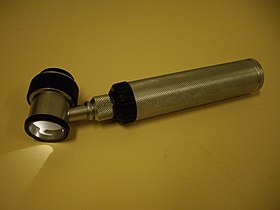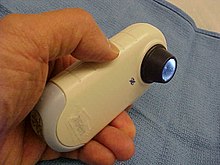| Dermatoscopy | |
|---|---|
 Immersion oil dermatoscope. | |
| Specialty | dermatology |
| MeSH | D046169 |

Dermatoscopy, also known as dermoscopy[1] or epiluminescence microscopy, is the examination of skin lesions with a dermatoscope. It is a tool similar to a camera to allow for inspection of skin lesions unobstructed by skin surface reflections. The dermatoscope consists of a magnifier, a light source (polarized or non-polarized), a transparent plate and sometimes a liquid medium between the instrument and the skin. The dermatoscope is often handheld, although there are stationary cameras allowing the capture of whole body images in a single shot. When the images or video clips are digitally captured or processed, the instrument can be referred to as a digital epiluminescence dermatoscope. The image is then analyzed automatically and given a score indicating how dangerous it is. This technique is useful to dermatologists and skin cancer practitioners in distinguishing benign from malignant (cancerous) lesions, especially in the diagnosis of melanoma.
- ^ Berk-Krauss, Juliana; Laird, Mary E. (2017-12-01). "What's in a Name—Dermoscopy vs Dermatoscopy". JAMA Dermatology. 153 (12): 1235. doi:10.1001/jamadermatol.2017.3905. ISSN 2168-6068. PMID 29238835.